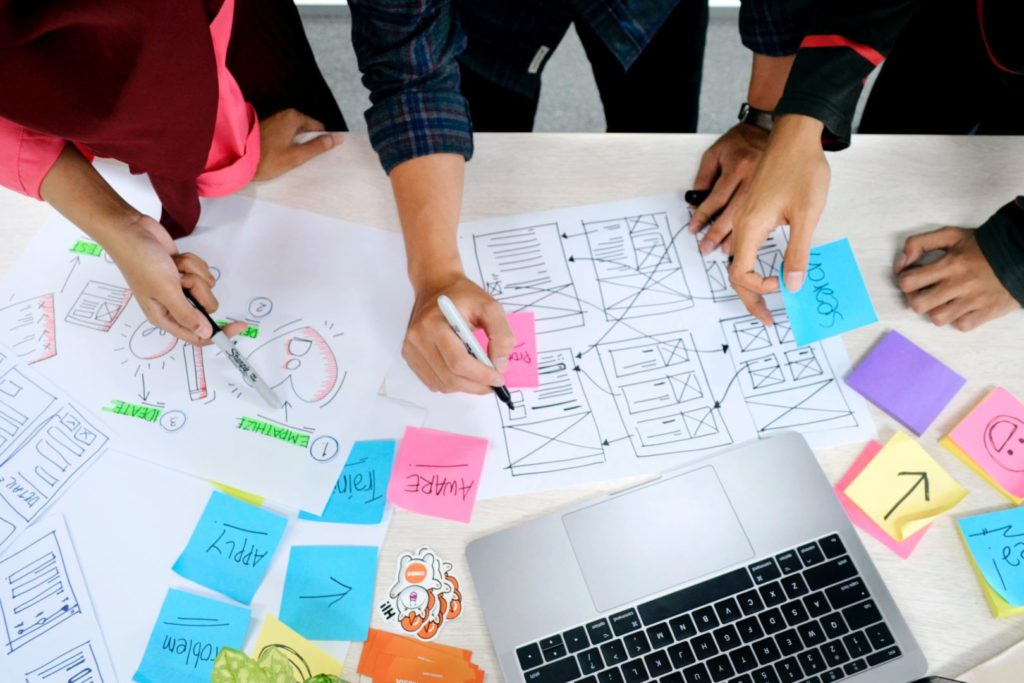The official definition of design thinking explains it as a non-linear, iterative process that teams use to understand users, challenge assumptions, redefine problems and create innovative solutions to prototype and test.
That is a mouthful and was most likely created by someone who is experienced in its practice but not as polished when it comes to communicating ideas.
Before we can dive into how Design Thinking can be integrated into your marketing strategy, we need to gain a deep understanding of what it is.
The definition above uses several terms that we are familiar with, so gaining a basic understanding of this concept will not be difficult. In more simple terms, design thinking is a way for a team, who is creating a product, to look at the entire picture of a project before moving forward.
It allows them to understand who they are creating this product for and identify what issues they may need to overcome along the way. It is also a way to propose solutions that are developed enough to be tested but not so far along that they cannot make changes.
Why Is Design Thinking Important?
Design Thinking has been leveraged by the world’s most innovative brands such as Google, Apple, and Airbnb. It is a critical practice because it provides teams such as developers with a process that allows them to create solutions that will best serve the end-user.
Design Thinking is a process that has guided designers for years to be able to create better products.
Ian Peterman, CEO Tweet
It also allows them to think outside the box and produce solutions that have never been tried before but have a high chance of succeeding because of the research they have conducted. The process that is Design Thinking can be broken down into five key phases: Empathize, Define, Ideate, Prototype, and Test.

STAGE 1: Empathize

Empathy is defined as the ability to understand and share the feelings of another. For example, if your best friend loses their job, you are able to understand the pain they are going through even if you have never been laid off yourself.
That is practicing empathy. In terms of Design Thinking, this is the stage where you commit to gaining a deep understanding of the problem you are trying to solve.
This can be done by conducting user research. Remember, the product you end up creating must solve a significant issue and be relatively easy to use. Your research should focus on understanding what pain points the user is experiencing and what they would like your solution to include. This is key because it allows you to set aside your assumptions and understand what the real issues are.
For example, let’s say you are redesigning a website for a global brand. You may assume that the reason visitor activity is low is that the user is not interested in the products they are viewing.
However, once you actually interview the user, you learn that they find the website to be difficult to navigate. You may also learn additional facts such as the pages are slow to load or that they contain multiple dead links that don’t lead anywhere. Now you understand what needs to be fixed in order to develop a successful new website.
STAGE 2: Define
Once you have gathered your information from stage one, you must review it and define the core problems that need to be solved. This is where you layout your problem statements, which define the issue at hand and detail the gap between where you are now and where you need to get to.
Going back to the example we listed above, one of your core problems is that users are currently being sent to a website that is difficult to navigate and produces a poor, frustrating user experience.

In some cases, it is helpful to develop personas to remember who you are solving these core problems for. Personas are semi-fictional profiles of the types of people who will be using your finished product. As you develop your product, you will want to refer back to these personas when making decisions.
For example, if your persona describes someone who is in a rush, you may decide to make key pieces of information easy to find at the top of the page, instead of placing them into a slider below the scroll.
STAGE 3: Ideate

This is the stage where you begin to develop your ideas on how to solve your core problems. This is where you can review the information you have gathered, look at the entire picture, and propose ideas that may be considered “outside the box”.
In other terms, this is where you can propose innovative and alternative ideas that will not only solve your problem but provide a long-term solution that will leave the end-user impressed and satisfied.
This is the stage where the world’s most innovative brands begin to develop products that set them apart from the competition.
When presented with a core problem, there is usually an easy way to fix it. For example, if people find your website confusing, you can remove pages and words so there is less content for them to go through. While this may solve part of the problem in the short term, the end-user is still going to be dissatisfied with your site because now it doesn’t include what they are looking for.
As a developer working their way through this process, it’s your job to find a way to redesign your website so it is easier to use, contains the same amount of key information, and provides a positive experience that encourages the user not to navigate over to the competitors’ website.
STAGE 4: Prototype
This is the stage where you begin to experiment with different ways to solve your core problems using the innovative ideas you produced in phase three. This allows you to get creative and implement alternative solutions with minimal risk.
If an idea fails in this stage, it will not be seen by the end-user and therefore can be dismissed quickly. If one of your groundbreaking ideas is successful you can point to the prototype as proof that it works. This will be helpful when trying to get your project stakeholders to sign off on implementing the idea into the final version.
In terms of a website, a prototype can start as a series of wireframes or a mock-up design. This allows the client and other stakeholders to gain a clear idea of where you are going with your thought process and what the end result may look like. You may also implement these changes into a staging version of your website that is not able to be seen by the public. The benefit being that the stakeholders can see your ideas in action and test them out for themselves. However, you only want to enter this phase after your initial wireframes have been approved. You will want to avoid spending time and resources on developing a staging site only to be told that you have to go back to the beginning.
STAGE 5: Testing
In this stage, you as well as the key stakeholders will test the prototype and record their findings. It is important to understand that you will most likely conduct several tests before launching your final product. This is because testing often reveals new problems that you have to go back and try and solve. The testing stage is also where innovative ideas come to die simply because they don’t actually work when put to the test.

Testing a new website can take weeks because of the back and forth it causes between the development team and the stakeholders who need to approve it. Commonly, a stakeholder may approve a prototype in stage 4 only to change their mind in stage 5. It is also common that certain high-level stakeholders are not consulted until the final testing stage. In some cases, this results in ideas that were originally approved to be vetoed by someone who is seeing the site for the first time.
It is key to underscore the importance of internal testing before turning your product over to the stakeholders to review. This is mainly because there will be certain parts of your product that need to work but only someone with your background knows how to test it properly. You also want to fix any obvious errors to avoid damaging your reputation. When a product is turned over to a stakeholder for review, their feedback should be centered around design and functionality. They should not be catching errors and mistakes such as typos or dead links.
What Tools Are Needed For Design Thinking?
As you can see in the example explained in the steps above, design thinking involves multiple teams working on the same project. Therefore, the first tool you will need before using this strategy is project management software. These tools ensure everyone working on a project is on the same page. You start by inserting the various tasks that need to be completed for each phase of the project. Then you assign each task a due date and someone to be responsible for it. Popular project management platforms include Asana, JIRA, and Basecamp.
Additional tools will be based on the type of graphic design that is needed for your project. This may include web design tools such as Adobe Photoshop, Figma, Sketch, or Marvel. If your product is web-based, you will need to look into what programs are needed to host your digital asset and what tools your team needs to make the necessary updates and additions. Lastly, you will need a communication platform such as Slack, that allows your team to quickly send messages and share documents without having to bother with e-mails.
How Much Does Design Thinking Cost?
It is difficult to put a specific price tag on how much a design thinking process will cost because it depends on several variables. However, as a business owner, you can list out these variables to gain a sense of how much budget needs to be allocated to different areas. First, you need to determine how many different departments are involved in this project. Then, you need to consult with those department heads to understand how many different team members will be needed to complete the deliverables you had in mind.
Once you determine the resources you need, you will have to calculate the tools they will need to begin working on the project. Some of the tools listed above such as Adobe and Slack may already be in place. However, if your team is not usually working on projects of this magnitude you may need to purchase a project management software or upgrade the one you currently have. It is also important to identify if you will need to leverage the skills of someone outside of your company for this project such as a copywriter or graphic designer.
When considering the cost of implementing a design thinking process, it may be worth trying to calculate the cost of not doing it. For example, if this upcoming project has the chance to push your company to the next level, what does that mean in terms of profits? It may be worth shelling out the cash upfront for additional staff and tools if the result is a long-term increase in growth and profits.
How Do You Hire A Design thinking Team?
As you consider the cost of ramping up your team for your next project, you may want to consider outsourcing the bulk of the process to an agency with a proven track record. Remember, this project may be a top priority now, but what happens when it is over?
Will you have enough work for those people that you hired? Furthermore, what happens to the work your team was supposed to be doing before you pulled them into this new project.
The Peterman Firm specializes in conscious product development and has been implementing its own process on behalf of emerging brands for years. The Peterman Method™ is a type of design thinking process that focuses on each of the stages we outlined before and even includes an additional step to cover profits.
Our goal is to provide you with the knowledge, advice, and resources your companies need to harness the power of design thinking without exploding your budget or making costly mistakes along the way.
This proven Peterman Method™ process is broken into seven equally important steps:
- Legacy and Impact
- Feasibility and Roadmapping
- Design
- Engineering
- Marketing
- Launch
- Profit
To learn more about each of these steps and how they would apply to your next project we invite you to visit our official website and click the ‘Let’s Talk’ button in the right-hand corner to schedule a free introductory call. This will allow our team to present our full method, learn more about your brand and let you ask any questions you may have.
Your Next Steps
Related Design Thinking BLOG Posts
Supply Chain And Its Importance
Supply chains are what make any product possible. While it may sound like something only used for large businesses, it is not. Every business has one, whether you realize it or not. We’ve mentioned supply chains before in our Kickstarter Manufacturing post, but I wanted to dive into it more. I cannot stress the importance of your supply chain enough. Understand Your Supply Chain Understanding and maintaining your supply chain, even if it’s just one or two people or companies is important. Just to get a single pen for you to use at your company involves a pretty long supply chain. From gathering the raw materials, to manufacturing, to distributing, to you receiving the product. Your product has a supply chain as well. It might involve just a couple suppliers, one distributor, and the end customers, but it still exists. A breakdown in that chain can mean company failure, bad press, or profit loss that affects you for years. Sourcing When sourcing for companies, we look at as much of the supply chain as we can see. Hiring Your Outsourcing may be a valuable use of assets depending on your company size. Many companies keep their exact supply chain hidden in order to keep ahead of competition or many other reasons. The longer the chain the more potential issues can arise. Always look for the shortest chain possible, go direct to manufacturers instead of buying from end distributors for sourcing your products components. Longer supply chains also make for more expensive parts. Backups When possible, always create backups for your suppliers in case something goes wrong. While you can’t always have this, especially if you use specialty suppliers, you should always try to have a backup. Manufacturers close down, change services, make certain products obsolete, stop producing a product, etc. Unfortunately many of these issues can appear with no advanced warning, causing other issues for you. Supply chain management and set-up is an investment. The cost of a poor supply chain can be more than the cost of setting it up right. It can also cause long term damage to your company. Because of this, I advice every start-up to rethink, even if you think that the investment is too high. An investment like this will seem small after you’ve successfully weathered suppliers closing, product failures, and other issues. This means you are still providing the best product possible to your customers and that is a win in my book. You’ll also benefit from happy customers by ensuring you can provide your product to them without issues. Author Mr. Peterman View all posts
7 Questions to Ask Before Starting a “Rush” Job
Are you in a rush? There are key advantages to paying for expedited service in the product development world, but overusing the magical term “it’s a rush job” won’t do you any good if you can’t back it up. When you tell your developer or designer that you have a rush job for them, you should know a few things about the process, and how it will impact your project. Some developers love them, some don’t do them. Knowing what it means for your developer when you say your project is a rush job, will help make sure things go smoothly, and everything gets delivered on time and to spec. Here are some answers you need to rush your project successfully: Is it really a rush job? It’s important to know when a job is really a rush job or not. Everyone has their own definition. Ian Peterman, CEO Tweet Make sure this is really a rush job for you. What are the driving factors that are making you want to set your project as a rush job? Talk with your developer, and make sure deadlines are understood. It might be that you thought it would be a rush job, and it isn’t. Don’t just call it a rush job if you are afraid your project won’t be taken seriously or done on time. Great developers always deliver on time or keep you apprised of any delays. In my firm, “rush” means drop everything and rush to get the project complete, and we charge accordingly. Are you available for quick and frequent communication? You are asking that your developer drop what they are doing and rush to take care of you. When you do that, the most frustrating thing you can do is take forever to respond or give edits, or be unresponsive at all. If you are not available to respond as quickly as possible to your developer, you are going to slow the project down, and show your developer that you do not actually view the project as a priority. Do you have a scope of work? BLANK Ian Peterman, CEO Tweet This is absolutely necessary when working with rush jobs. Because the project is being rushed, you don’t want to waste your time or your developers. Making sure you have a list of changes, edits, and/or deliverables before you even mention the word rush to your developer is very important. During any job and (especially with rush jobs) if it isn’t in writing it’s not going to happen. Do you have all materials ready to give to your developer? If you are in a rush, make sure you have everything you need to share with your designer / developer. Ian Peterman, CEO Tweet Make sure you have more than everything you think your developer might need. You should do this with any project, but when it is a rush job time matters even more and your developer will be impressed and appreciative if you can produce everything they ask for quickly. Using a file sharing service is often a great idea as you can put everything they might need in one “folder” and share it with them. Does your developer do rush jobs? An important question that you might not necessarily think of asking. Some developers I’ve worked with don’t do rush jobs at all, for which there are many reasons. Sometimes it’s a matter of schedule, or maybe they have a rush job already this week and are busy, even though they’d love to do it. It’s very important to make sure they really can squeeze your project in on your timeline. Especially with less experienced developers, their eyes can be larger than their stomach so to speak. Are you committed to your project? If you tell people it’s a rush job and get people to move quickly, regardless of whether you paid more, make sure it’s actually a rush job. Hurry up and wait is frustrating for everyone, don’t do it. Ian Peterman, CEO Tweet With any rush job, you are setting a high level of expectation and commitment from your developer. You should match them. If you loose focus, start to change the project, or give other signs that you aren’t committed, those are red flags to your developer that it isn’t really a rush job, and they might not take it as seriously as you want them to. Getting your design services expedited will no doubt help you capture revenue opportunities. In order for your rush to be a success make sure you are as committed and prepared as your developer/ design team. Your Next Steps 4 Things your Scope of Work needs Learn about the top 4 things your scope needs. Scope of Work product developers 5 Ways to Maximize Your Developer’s Potential Effective Product Developer Related Conscious Design BLOG Posts Author Mr. Peterman View all posts
What do you Bring to a Developer?
This is an interesting question as it depends on the developer! You may be familiar with what you should have for your web developer or a house developer, and the intent…


